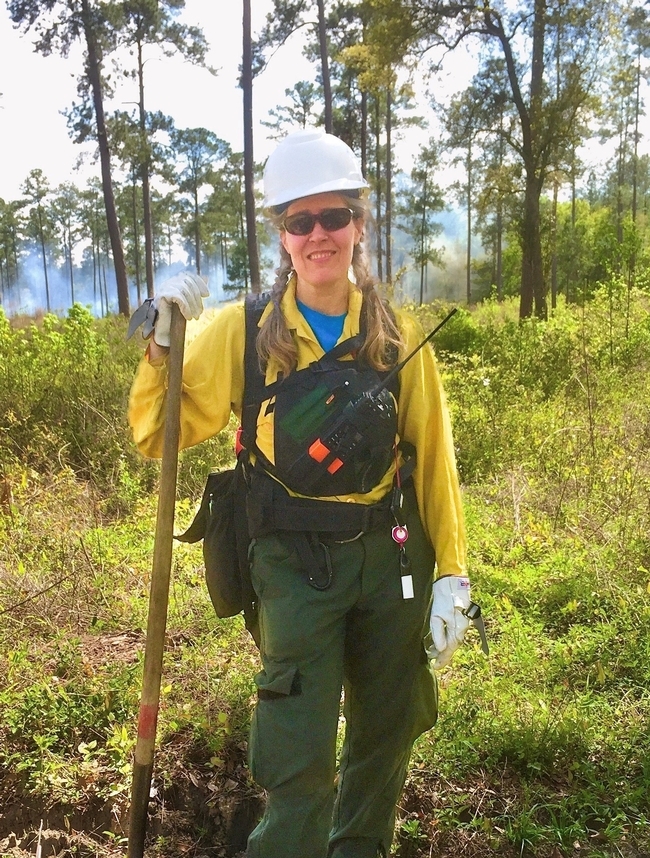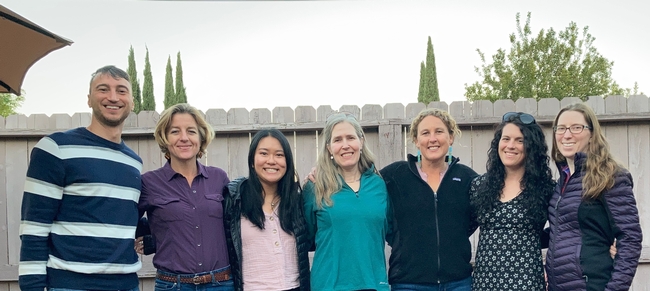In the wake of California's increasing wildfire concerns, UC ANR has made a concerted push to expand their fire network by hiring more academic advisors like Barb Satink Wolfson. Satink Wolfson covers the central coast region of California, serving the communities of San Benito, Santa Clara, Santa Cruz, and Monterey Counties. This is her first fire-focused position in California- but is far from her first time working in fire science and communications. Prior to moving to the Central Coast in 2022, Satink Wolfson established a presence among Arizona and New Mexico communities through creative methods of science communications.
Past projects in Flagstaff, AZ were focused on helping researchers communicate their findings to the public and on the ground land managers. One unique effort saw researchers partner with a local art council on a climate and fire art exhibit, which was exhibited in Flagstaff and Tucson. Local artists conveyed difficult fire ecology and management concepts in a more approachable medium, positively shifting visitors' attitudes towards active management. Satink Wolfson feels that her current position as fire advisor is a natural progression to scale these creative outreach efforts.
Now, Satink Wolfson has found that the people she serves are fairly fire-savvy, most likely due to the past wildfires such as the 2020 Lightning Complex Fire. “There's definite awareness, and some very active FireWise communities,” Satink Wolfson says, pointing to the region's Fire Safe Councils as a prominent example that assists with FireWise establishment.
She has endeavored to build on that community interest by inviting people to be curious about fire and management. For example, through her local Prescribed Burn Association (PBA), she invited the public to observe the prescribed fire process, from morning briefing to ignitions. “People really liked seeing that process,” she recounts. She expands on demystifying science, “I strive to use common language, limit acronyms, spell everything out.” Making those choices has a positive impact on community engagement and empowerment. Another essential part of empowering the community is ensuring that all community members are included, which is why Satink Wolfson is also a strong supporter of including tribal perspectives and tribal members for these projects.
“It's a long road to environmental justice,” Satink Wolfson tells me. There are some steps in the right direction, she says, including her local PBA allocating a portion of their grant funds for tribal apprentices, aiding the local Amah Mutsun Land Trust's efforts to bring fire education back to their members. The Association for Fire Ecology (AFE) is an organization Satink Wolfson has been contributing to for some time now, and their biannual conference is one that she “tried for years to bring in a larger component for indigenous people,” she says. This year is the first to include a large number of events specifically designed to welcome and pay respect to indigenous culture and history. “It makes me feel good that we're finally getting there, and the right partners make all the difference,” Satink Wolfson notes, referring to a local indigenous leader who is leading the facilitation of indigenous events, topics, and culture at the conference.
Environmental justice is not the only issue Satink Wolfson sees in her region. A more tangible hurdle is money- there's simply not enough to go around. She says that “For middle income people in my area, finances are one of the hardest hurdles for defensible space and home hardening.” Fire safety projects are typically done on an individual level, leaving it up to each homeowner to come up with resources and funds on their own.
Satink Wolfson points out that this concern infuses not only her advisor goals for the region, but the content she presents to the public. She's cognizant that “not everyone can afford to do everything at once,” and instead approaches management talks from the perspective of: “What can get people the biggest bang for their buck?” Her recommendation is to prioritize management projects through this lens, sharing: “The way that I look at my house is- I want to make it as likely as possible that it can survive a fire without intervention.”
This is why Satink Wolfson wants to work her way towards neighborhood-level action. She thinks about the impact of having large-scale, coordinated efforts that lead to saving an entire neighborhood from a wildfire. While working with Homeowner's Associations is a possibility, she would prefer a more grassroots effort. Community-led programs are the way to go, she notes, “That's why the Fire Safe Councils can be so effective.” This is the positive, people-powered model she sees groups like the PBAs building upon: “I see the PBAs as returning fire to the people. Anyone can do the work, they just need to know how.”


